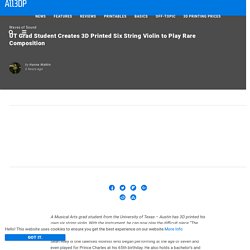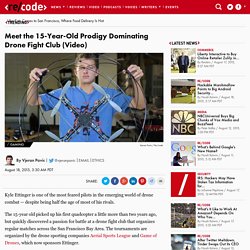

25 Best 3D Printer Filament Types & Comparison Charts. How Desktop 3D Printing is Moving From Makers to Pros. We've all seen the results of desktop 3D printing.

And let's be honest, the results have often been less than impressive. Things like homemade toys and models have a certain cool factor, but once that wears off you have to ask yourself, is a desktop 3D printer just a $3,000 tchotchke maker? That's not to discount however the things being done by makers and the DIY movement. Armed with a 3D printer and a Raspberry Pi, a creative hobbyist can make all sorts of gadgets. But the question for the 3D printing community at large, as well as printer manufacturers, is how can desktop 3D printing move out of the hobbyist realm and deliver on its promise of becoming a professional tool as ubiquitous as a desktop PC? UT Grad Student Creates 3D Printed Six String Violin to Play Rare Composition. A Musical Arts grad student from the University of Texas – Austin has 3D printed his own six string violin.

With the instrument, he can now play the difficult piece “The Dharma at Big Sur”, which was written by composer John Adams. Sean Riley is one talented violinist who began performing at the age of seven and even played for Prince Charles at his 65th birthday. 3D Printing Activities to Try in Your Classroom. 3 Reasons Why Robotics Promotes a Culture of Creativity in the Classroom.
To meet the challenges of the modern workplace, today’s education is calling for curriculum that integrates STEM learning and creative problem solving in the classroom.

I have found that creativity in the classroom is better harnessed when it is encouraged and is critical for today’s students, particularly when using robotics. Below are the top three reasons I believe robotics can promote a culture of creativity in your classroom, ultimately helping propel the next generation of innovators forward: 1. Robotics offers a new idea of what creativity looks like One common misconception about creativity that many of my students have is that to be creative, you need to have a knack for drawing, painting or storytelling. By being creative as teachers and incorporating robotics into our lesson plans, we can show students that it is possible for creativity to go hand in hand in math, science, coding and more. 2.
Robotics frequently present open-ended challenges that do not lead to single solution. Watch: The paper-airplane drones that may one day save your life - Recode. Robot Revolution: Intelligence In, Intelligence Out. Robotics Robot Revolution: Intelligence In, Intelligence Out By Greg Thompson08/03/16 The familiar garbage in/garbage out axiom has long been a mantra of computer programmers, and nowhere is the cause-and-effect principle more apparent than when working with robots.

Faced with the three-dimensional movements (and sometimes audio vocalizations) of robots, students across the grade spectrum can see the direct results of their input. Robot Revolution: Intelligence In, Intelligence Out With the hope of introducing robotics in younger age groups, the Parkland School District in Allentown, PA, aimed to spread its considerable secondary grade success to the primary grades. Starting with Dash and Dot robots, Edwards helped K-5 students learn the basics of computer programming/coding.
The added "integration" dimension has educators counting the possibilities. Robot Revolution: Intelligence In, Intelligence Out.
Check out this @Flybrix Lego Quadcopter kit!!! Programmable too... Learn create tinker - #aussieED #digitaledchat. Finding purpose for 3D printers in schools. 3D printing at Mahtomedi High School in the outer Minneapolis suburbs has come a long way in four years.

In 2011, the school first opened its fabrication laboratory, or FABLab, with a single 3D printer so students could bring high-level designs to life. 3D printing was too costly for most K12 school leaders, but four years is an eternity when it comes to new technologies. Today, Mahtomedi High—part of the Mahtomedi Public School District—operates six 3D printers. When it came time to replace the old machine, school officials decided that—because prices had dropped considerably—it made more sense to address growing demand with several, less-expensive models. Those units can cost around $2,000 each, with metal, plastic, wax and other materials costing 30 cents per gram.
Top-of-the-line models cost $7,000 or more with materials at 30 cents per gram. 3D printing offers multiple ways for students to get hands-on experience and to gain marketable skills before leaving high school. Hummingbird Robotics Kit. Need some inspiration?

Here's three videos of robots built with Hummingbird kit materials, arranged in order from easiest to hardest to build: Chris' Horse. Estimated build time: 30-45 minutes Emily's Dog. Estimated build time: 2-4 hours Jenn's Dragon. Ozobot - Imagination in Play. The Verge sur Twitter : "A robot designed around disaster-preparedness is the winner of DARPA's Robotics Challenge.
Meet the 15-Year-Old Prodigy Dominating Drone Fight Club (Video) Kyle Ettinger is one of the most feared pilots in the emerging world of drone combat — despite being half the age of most of his rivals.

The 15-year old picked up his first quadcopter a little more than two years ago, but quickly discovered a passion for battle at a drone fight club that organizes regular matches across the San Francisco Bay Area. The tournaments are organized by the drone sporting companies Aerial Sports League and Game of Drones, which now sponsors Ettinger. He has worked with his father, Silicon Valley engineer Gary Ettinger, to design and construct a series of drones customized for combat. The growing fleet now takes up the better part of the family’s Cupertino, Calif. garage. In late spring, the Ettingers arrived at Maker Faire in San Mateo, Calif. to compete in the league’s biggest tournament to date, equipped with one of their latest designs.